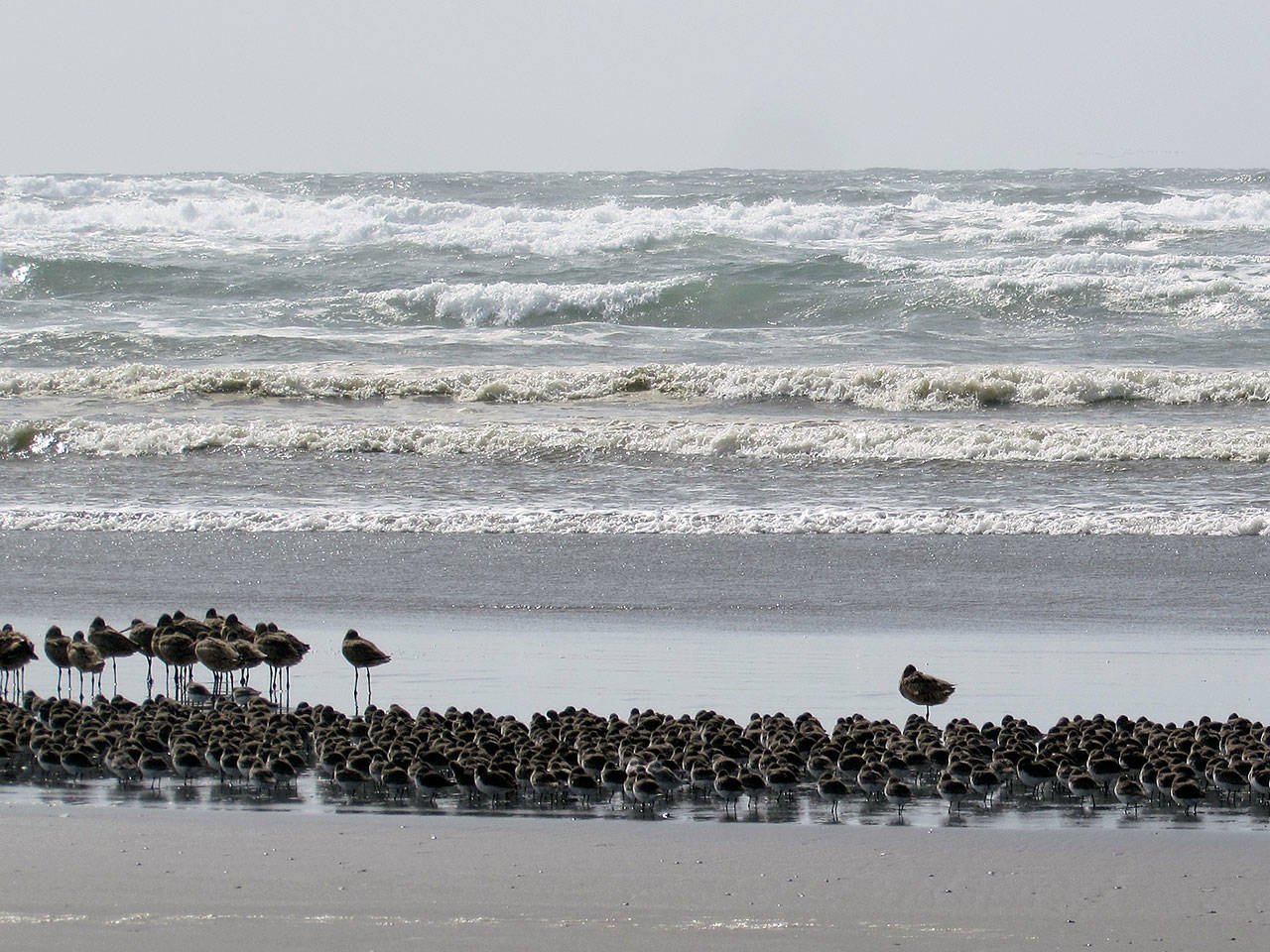By Dianna Moore
Grays Harbor Audubon
The spring migration is upon us and the edges of our harbor and beaches are full of small birds scurrying about feverishly, eating as fast as they can to put on fat for the next leg of their very long journey. These birds come from as far away as the southern shores of South America and are on their way to the northern reaches of the Alaskan coast and tundra for the most part. Each year they find changes in their stops along the way; either the beaches, ponds and estuaries have been compromised in some way with construction, pollution, or some other form of habitat loss, or the increasing severity of storms has impacted their feeding area in some way. So when they begin arriving on our harbor and beaches, we need to be aware of how thin their lifeline is being stretched.
Most of us are familiar with the year-round Sanderlings, the pale birds with the black legs and a fairly short black bill, most commonly seen running in front of each incoming wave. Then there is the Dunlin, a bit bigger with a black patch on its belly at this time of year, rufous cap and back, and a longer bill with a slight droop on the end. It too runs in front of the waves as they add yet another helping of biofilm to the surface of the sand and mud. One of the favorites is the Western Sandpiper, the male a more colorful bird in breeding plumage of rusts and black with white breast and belly covered with brown chevrons and a longer black bill than the rest of the smaller shorebirds. The smallest of shorebirds is the Least Sandpiper, mostly brown back and bib, white belly, yellow legs, and a fairly short black bill. They tend to stay separate from the other shorebirds. Then there is the Semipalmated Plover, a small bird with a short, black bill with orange at the base, a white forehead, black cap, a white collar on breeding males, a single black “necklace”, white breast, and dull to bright orange legs.
Moving up to larger birds, one of the more striking in breeding plumage is the Black-bellied Plover. While they are often seen in the company of the smaller shorebirds out on the beach, they really shine on the greens of a golf course where they can be found on many rainy spring days when golfers stay home. They stand tall and have a bright presence of black and white plumage against the green grass. Their bills are black and sturdy, about as long as the distance from base of the bill to the back of the head. Breeding males have a white head and down the back of the head to the shoulders, with black from the eyebrows down the chest and belly, and black wingpits. When disturbed, they raise their wings displaying those wingpits, then take off with many plaintive calls. They are usually the first to take off when humans get too close, then they stay together just offshore, flying and calling until they deem it safe to settle again. Both Long-billed and Short-billed Dowitchers are found out here but the Long-billed seems to be more common. In breeding plumage they are more rufous on chest and breast, a mottled buff and black back, a long, straight bill (longer in Long-billed), white eyebrows, and long grayish legs. One of the crowd favorites in the Red Knot, a bit later to the scene but much appreciated. Breeding plumaged birds have bright rufous underparts and a variably-patterned back of black, buff, rufous and white. It is more likely to be found in a separate group, particularly at Bottle Beach State Park in Ocosta. Another popular shorebird is the Lesser Yellowlegs. They are a slender, stylish-looking bird with a beautiful, distinguishing call, a long black bill, mottled and of course bright yellow legs, also often found on the golf course. Next up is the Marbled Godwit, a bit larger than the dowitchers and yellowlegs, with a long, bi-colored bill that turns up at the end. In the accompanying photo, they are the larger birds on the left in the back. We often see them on the rock wall on the east end of the Westport Marina in large flocks of 600 to 900 birds.
If you are interested in learning more about these and other migrating shorebirds, check out the Grays Harbor Shorebird and Nature Festival this weekend. There are field trips, lectures, children’s activities, and lots of helpful volunteers to answer your questions. Many visit the Grays Harbor National Wildlife Refuge boardwalk at this time of year to see these birds up close, or to watch as the birds all rise as one and fly in groups to avoid predators like the Peregrine Falcon or the Merlin. It’s free to visit the refuge; just leave your bicycles and dogs at home. Visit the web site at http://shorebirdfestival.com/.
Meanwhile, remember how much more distance they have to fly to get to their breeding grounds, and give them the chance to make that trip safely. Watch from a distance, let them eat in peace.
Thank you from all of us who love these birds!


